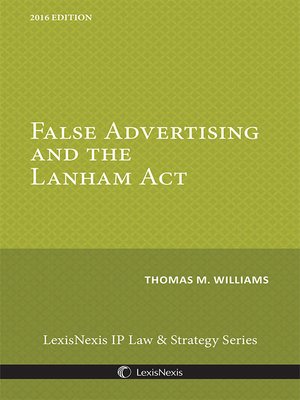
Sign up to save your library
With an OverDrive account, you can save your favorite libraries for at-a-glance information about availability. Find out more about OverDrive accounts.
Find this title in Libby, the library reading app by OverDrive.



Search for a digital library with this title
Title found at these libraries:
| Library Name | Distance |
|---|---|
| Loading... |
Section 43 of the Lanham Act is an invaluable tool for intellectual property and commercial litigators. It includes causes of action for trademark infringement-type "passing off" claims, false advertising, trademark dilution, and domain-name cyberpiracy. It is the cornerstone for civil litigants seeking redress for competition-related torts in federal courts. However, Section 43(a) is not a general catch-all for commercial grievances, and is arguably the most misinterpreted and misapplied subsection in the Lanham Act, despite having an extensive body of case law delineating specific causes of action and proofs. Practitioners are well-advised to grasp its nuances before proceeding under the banner of "unfair competition".In False Advertising and the Lanham Act Thomas Williams addresses false advertising claims under Section 43(a)(1)(B) of the Lanham Act. The product focuses on false advertising claims under Section 43(a), and specifically, Section 43(a)(1)(B). It connects the dots in false advertising precedent, from standing to sue through monetary relief, and includes analysis of key cases where courts have developed essential analytical tools for fleshing out the sparse statutory language. The 2015 Edition includes analysis of a number of new cases, including U.S. Supreme Court's decisions in Lexmark International v. Static Control Components, resolving the circuit split on whether antitrust-based standing rules are applicable to false advertising claims, and Pom Wonderful LLC v. Coca-Cola Co., which explores the interplay between Section 43(a) and beverage labeling regulations.Reviews "As an in-house counsel responsible for advising a widely dispersed, highly competitive business, I know that it's critical to understand the defensive and offensive applications of the Lanham Act, particularly as it relates to false advertising. Thomas Williams offers a comprehensive yet practical and engaging summary of the current parameters of Lanham Act false advertising claims. False Advertising and the Lanham Act is a 'must read' for every general counsel or in-house attorney who wants to reduce risk and protect assets." —David J. Adams, Deputy General Counsel, Vice President, Regulatory Affairs, Kaplan, Inc. "Tom Williams has created an exhaustive analysis of false advertising claims under the Lanham Act. Well written and insightful, this treatise thoroughly and thoughtfully summarizes Section 43(a)(1)(B), including the key court decisions essential to its interpretation. False Advertising and the Lanham Act is an invaluable desk reference for the commercial litigator, and a must for every intellectual property counselor's library." —Peter J. Albert, Associate General Counsel, The Progressive Group of Insurance Companies "Tom Williams' book, False Advertising and the Lanham Act, is written in a clear, logical manner and provides useful and thorough information about the court decisions that have developed the law in this area. It is a pleasure to read and will be a helpful tool for practitioners facing questions about positioning claims or defenses in false advertising conflicts." —Nancy Lee Carter, Senior Counsel - Trademark and Copyright, Kimberly-Clark Corporation, 1984 - 2012 "False Advertising and the Lanham Act is a practical guide to this area of law, and will be a helpful tool to practitioners, both in-house and in private practice. It is clearly written, easy to read, and comprehensive-a necessary addition to a well-rounded reference set." —Annaliese Fleming, The Trademark Reporter







